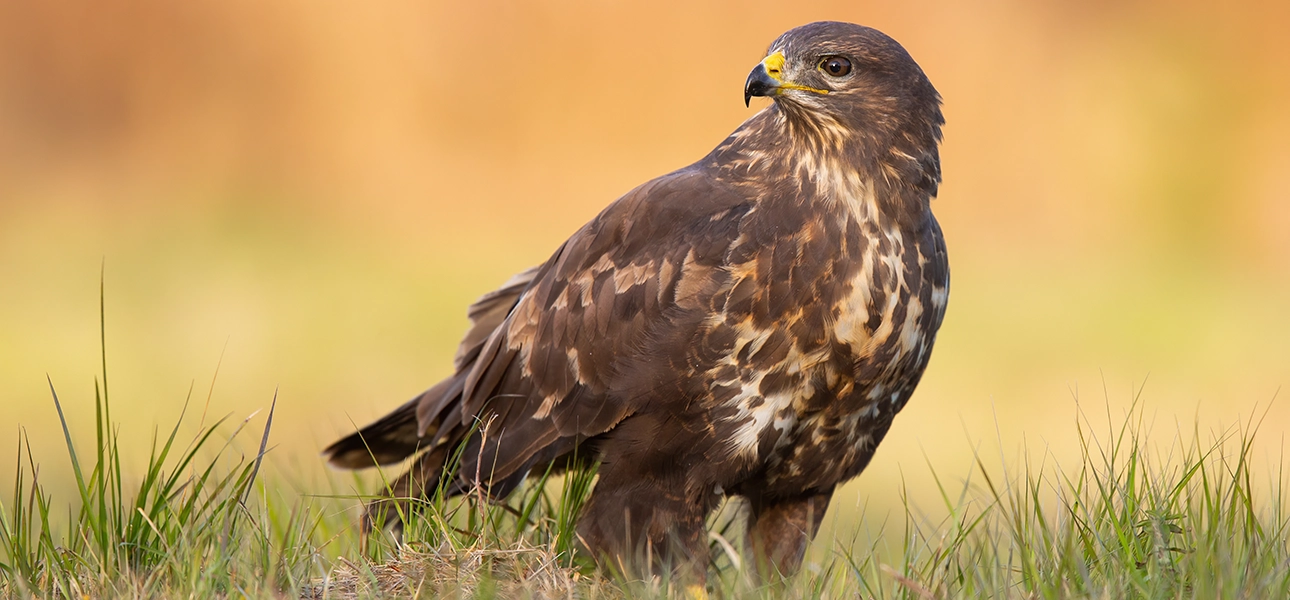
Common Buzzard (often just referred to as Buzzard), is one of the most familiar birds of prey. After recovering from an all-time low in numbers, they have successfully returned to much of the country where they can now be seen soaring on characteristic upward- ‘V’ held wings, flapping lazily along, or sitting patiently on posts or the ground. Often when sitting on posts, they appear to be contemplating their feet.
Key Facts
Common name: Common Buzzard
Scientific name: Buteo buteo
Habitat: Uplands, woodland, farmland and even urban areas
Diet: Rabbits and other small mammals, birds and invertebrates
Size: Average 54cm, wingspan 120cm. Females (1kg) heavier than males (780g)
Status: Resident breeder. Passage/winter visitor.
Population size: 63,000 pairs
Conservation status: GREEN (Least concern)
Appearance
Despite its familiarity, Buzzards can be confusingly variable in plumage. Normally, Buzzards are brown above and mostly heavily marked white below. They are stocky birds with broad wings and broad, shortish tails, and this shape can be an important clue to identify odd-coloured individuals. Almost all Buzzards, regardless of overall colour, will have distinctive ‘elbow patches’ on the underside bend of the wing. They usually also show a pale ‘necklace’ across the lower neck/upper chest. Some birds are remarkably pale, and others can mimic Rough-legged Buzzard colouration, although build and habits should help to secure a correct identification.
Lifespan
The average age in the wild is 12 years. Adults have 90% year-to-year survival. Young birds have a 63% chance of reaching their third year, when they begin breeding. The oldest known wild bird was 30 years and 5 months old (ringing recovery).
Nesting
Buzzards nest in mature trees, building a large stick nest. Although usually easy to spot, Buzzards are stealthy near the nest. It may be obvious if a pair is nearby when they are displaying, but locating the nest is a challenge.
Number of eggs: 2-3
Incubation: 34 days
Fledging time: 44-52 days
Habitat and Distribution
Buzzards are very widely distributed, and can be found in a range of habitats, from uplands and woodland to farmland and even urban areas. They are highly adaptable and, although shy, they readily get used to being in close proximity with humans. Buzzard numbers dropped very low, principally due to persecution and a lack of favoured rabbit prey during the height of myxomatosis and it retracted back, becoming very much a species of the ‘Celtic fringe’ of western Britain. Numbers have been recovering and with this has been seen an easterly spread back into previous habitats. It is still scarce on the Isle of Man and in western Ireland. Buzzard is now one of our most common raptors.
Movements
Across its vast world range Buzzard is highly migratory, although in the UK it is usually resident. This is related to its winter diet of small mammals and/or invertebrates, both of which become very difficult to access under snow. Britain’s oceanic mild climate and low incidence of heavy snow cover mean Buzzards can stay year-round. Numbers of Scandinavian birds can be encountered, especially in the east during passage and in winter, swelling our resident population.
Buzzard is a wide-spread species, occurring across Europe and Asia, and with many populations wintering in Africa, Middle East and India. Many sub-species have been suggested, and there is a gradual cline towards the east of Europe where Buzzard is described as Steppe Buzzard, usually more rufous in colour. Many authorities argue that Steppe Buzzard is actually a separate species.
Feeding
Buzzards are big birds, more than capable of taking sizable birds or animals but, more often than not, they will target smaller prey. Rabbits are an important food source, and the birds suffered during the height of myxomatosis, but they will also take smaller mammals. Compared to all other raptors, Buzzard’s digestive systems are able to deal with a poor-quality diet, and in winter when other prey is hard to find, they are able to feed mostly on earthworms, beetles and other small invertebrates. These will be hunted on foot, and you can find Buzzards regularly sitting on the ground. In favoured fields, large numbers can gather, and, although somewhat tolerant of each other, disagreements will break out if individuals get too close to others. In certain areas, usually in the uplands, Buzzards may hover when searching for food.

